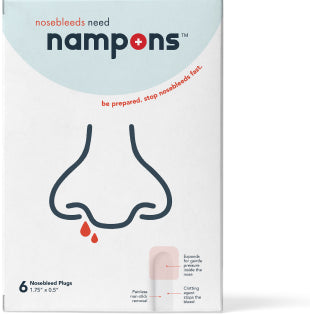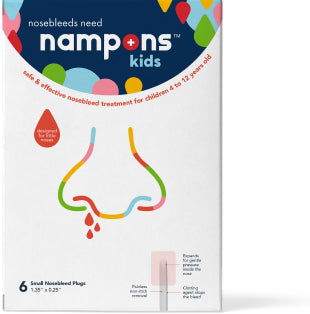This article was written by Dr. Drew Sutton, a retired ENT doctor who lives in the Southeastern US. During his 30 year career, he was an American Academy of Otolaryngology member and a Fellow of the American College of Surgeons.
What does an ENT think about when seniors have a nosebleed?
Most adults over 50 tend to have nosebleeds for different reasons than young adults or children. Even a small drop of blood can elicit high levels of patient anxiety and worry, which can worsen the nosebleed.
The site of bleeding can elevate the patient’s blood pressure, cause their heart to race, and even cause hyperventilation leading to fainting. There are few other episodes that can cause as much psychological trauma.
The first questions an ENT doctor encounters include, “Doctor, am I dying? Does this mean there is something really wrong?” Of course, fortunately, nothing could be further from the truth. Yes, a nosebleed may be serious, but it is always something that can be handled. And, no it doesn’t mean that it is a sign of a mysterious, underlying medical condition. It is possible that the nosebleed is not the only medical issue that needs to be addressed.
Patience and empathy go a long way in these instances. Providing a calming atmosphere may be the best treatment an ENT can do for a patient, particularly if other providers have been unsuccessful in stopping the nosebleed.
The first step for an ENT is getting the bleeding under control while providing some reassurance. Other medical problems should be treated simultaneously. In many cases, simple nasal packing such as Nampons or careful examination and cauterization does the trick.
What sets older people apart when it comes to nosebleeds?
As we age, our skin and mucosal linings such as in our nose can be more susceptible to dryness. This is especially true in colder climates. Many seniors come into the office or emergency room during the winter months with nosebleeds from excessive nasal dryness usually from radiator heating.
Often, the best advice is to humidify the air with a cool mist vaporizer. After the bleeding has been controlled, patients should use direct, local application of bacitracin or petroleum ointment to the front part of the nose. It helps with moisturization and prevents itching.
Older people are more likely to have undergone trauma or prior surgery than younger patients. Some older patients have long-standing sinus or allergy problems that cause nosebleeds.
Most importantly, many older people are taking various medications that may cause inadequate blood clotting, and have effects on their heart, blood pressure, blood sugar levels, kidney and liver function, and more. Seniors may be taking medications such as blood thinners, dealing with hypertension, diabetes, or vitamin K deficiency, or suffering from mild kidney or liver insufficiency. Seniors may have underlying hypertension, vitamin K deficiency, kidney or liver insufficiency, diabetes, arthritis, or other autoimmune disorders. All of these can contribute to nosebleeds.
Finally, the ENT needs to assess whether the patient has fever, respiratory symptoms, has any current exposure risk of COVID-19, determine what their blood pressure currently is, and if they are in pain. By taking into account all the relevant medical problems, the ENT can determine what the best course of action will be. Sometimes, treating a respiratory infection must be part of stopping the nosebleed if the patient is to go home from the clinic or hospital.
Treatment
Bleeding from the nose is usually anterior, meaning it comes from the front part of the wall separating the left and right sides of the nose called the septum. The septum may have curvature, or be “deviated.”
The airflow is faster, and more drying, in the narrower areas of the nasal cavity. This is a concept related to Bernoilli’s Principle in physics. Without getting too technical, as we breathe the air into narrow areas of the nose, the air moves at a higher speed, causing lower air pressure which has a drying effect on the nasal lining.
A real-life example is to imagine standing along the road and a truck moving very fast. That truck creates low pressure. That low pressure stirs up dust and debris, literally pulling us toward the truck. The same thing happens in narrow areas of the nose, the low pressure pulls the moisture from the nasal lining.
In some cases, bleeding can be controlled with cauterization, either with electrical current or chemicals such as silver nitrate. Usually, this stops the bleeding, but it can be temporary, especially in seniors who have multiple areas of nasal dryness or irritation.
This is why nosebleeds in seniors may also require nasal packing. Most nosebleeds are anterior, in the front of the nose but the bleeding occurs in multiple areas. Nampons are a fast, efficient way to control most anterior nosebleeds even in the most challenging circumstances.
What do ENTs do differently than other doctors?
Aside from stopping the nosebleed, it is essential to do a full clinical assessment to determine what is, if any, the underlying cause of the nosebleed. As in any aspect of medicine, there is an art to controlling nosebleeds.
ENTs are faced with multiple tasks in problem-solving when someone comes in with a nosebleed. Ironically, patients are 100% concerned about the nosebleed while the ENT may be more concerned with other aspects of the patient’s history and care.
It can be very challenging in these settings for the ENT to get all the relevant history. Patients complain, “The doctor doesn’t have to know about my kidneys or heart or whether I smoke, he/she needs to stop my nosebleed!”
Of course, nothing could be further from the truth. ENTs must take the entire clinical picture into account and figure out why certain treatments are necessary and if conservative nasal packing will be effective.
Examples of Clinical Dilemmas
A good example of a clinical dilemma is to think about the relationship between a migraine headache and elevated blood pressure. A patient may complain of a crushing migraine headache because they believe their blood pressure is so high.
On the contrary, the migraine itself may be responsible for the cause of enough pain that it causes a rise in blood pressure. It takes clinical experience to determine which came first, the migraine or the hypertension, and which to treat. The clinical dilemma is what to treat first, the migraine, the high blood pressure, or both.
A similar clinical dilemma can occur with a nosebleed. A nosebleed can cause anxiety and cause severely elevated blood pressure. But, uncontrolled high blood pressure can also cause a nosebleed. So, what comes first and how does an ENT treat the nosebleed?
An ENT doctor will stop the nosebleed with cautery or a packing such as Nampons, but no treatment will be successful without calming the patient and reducing any hypertension. Both measures must be part of the overall game plan.
Key Takeaways
- Seniors face more potential causes of nosebleeds in general.
- Nampons provide a safe, effective tool for the control of nosebleeds in seniors because the causes of bleeding may be multifactorial and affect multiple areas of the nose.



